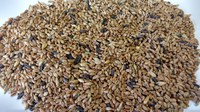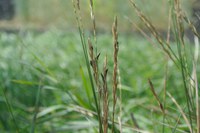Beware of Ergot-contaminated Livestock Feeds
(Click an image below to view a high-resolution image that can be downloaded)
Although ergot is not a new problem in North Dakota, more of it is being documented in several areas of the state, according to Gerald Stokka, North Dakota State University Extension veterinarian and livestock stewardship specialist.
Ergot is a fungal disease that can develop in grasses and cereal grains, and it can be toxic to livestock that consume it.
“Ergotism is generally a sporadic disease that can affect ruminants, horses, swine and humans,” Stokka says. “Clinical signs in cattle are gangrenous (death of soft tissue) or cutaneous (affecting the skin) ergotism, lameness, elevated body temperature, reduction in feed intake and possibly reduced fertility.”
Ergot sclerotia (hard, dark fungi bodies) mature at the same rate as plant seeds and can fall to the ground to overwinter and possibly germinate the following year. The purplish-black, hard ergot sclerotia contain toxic alkaloids (organic compounds of plant origin) responsible for ergotism in animals. Symptoms typically are the death of most or all of the cells in the tip of the ears, tail and coronary band above the hoof wall.
“Milk production can decrease in animals exposed to ergot alkaloids,” says Michelle Mostrom, a toxicologist at the NDSU Veterinary Diagnostic Laboratory.
“This spring’s cool and damp weather delayed planting of cereal grains,” says Andrew Friskop, NDSU Extension plant pathologist. “In June, this weather contributed to the germination of ergot sclerotia, leading to spore release and infection in grass hosts.”
Ergotism is most prevalent in late summer, when the seed heads of grass mature.
Cereal grains such as rye, triticale, wheat, barley and oats and a variety of grasses (brome, timothy, quack grasses, blue grasses and others) can develop the ergot body in the grains’ seed ovary.
The amount of ergot alkaloids in sclerotia varies widely. Ruminants consuming rations with 0.3% to 1% or more sclerotia can develop gangrenous ergotism. Researchers estimate that ergot alkaloid concentrations between 0.2 and 0.8 milligram per kilogram or part per million in the total feed ration can produce ergotism in livestock.
“The key to the successful treatment of ergotism in animals is early recognition of the clinical signs and removal of the animals from ergot-contaminated grains, hay, processed feeds or pastures,” Stokka says.
“The risk of ergotism increases in pregnant and lactating cows,” he adds. “Watch mammary development in susceptible animals for earlier recognition of the disease. Also, visually monitor feed for the presence of ergot sclerotia.”
Because of the huge variation of different ergot alkaloid concentrations in individual sclerotia, the evaluation of sclerotia in grain by weight for toxicity is misleading. Mostrom recommends producers submit a representative sample of grains and grasses to a veterinary diagnostic lab for ergot alkaloid testing before feeding it to livestock.
The analyses will provide information on the risk of ergot alkaloids to different species of animals. The NDSU Veterinary Diagnostic Laboratory at Fargo (https://www.vdl.ndsu.edu) analyzes grains and grasses for ergot alkaloids. Ergot testing is not performed in biological tissues.
Extension specialists recommend that producers also avoid feeding animals grain screenings, which can contain a higher proportion of ergot bodies. Screenings can contain many seeds or material.
Karl Hoppe, Extension livestock systems specialist at NDSU’s Carrington Research Extension Center, says identification of ergot in grain screenings is important. He recommends producers look for black kernels and break them in half. If the black kernel is white on the inside, it’s indicative of ergot. If the center is black, it might be rat feces instead of grain. Both should be avoided for livestock feed.
NDSU Agriculture Communication – Sept. 19, 2019
| Source: | Gerald Stokka, 701-231-5082, gerald.stokka@ndsu.edu |
|---|---|
| Source: | Michelle Mostrom, 701-231-7529, michelle.mostrom@ndsu.edu |
| Source: | Andrew Friskop, 701-231-7627, andrew.j.friskop@ndsu.edu |
| Source: | Karl Hoppe, 701-652-2951, karl.hoppe@ndsu.edu |
| Editor: | Ellen Crawford, 701-231-5391, ellen.crawford@ndsu.edu |



